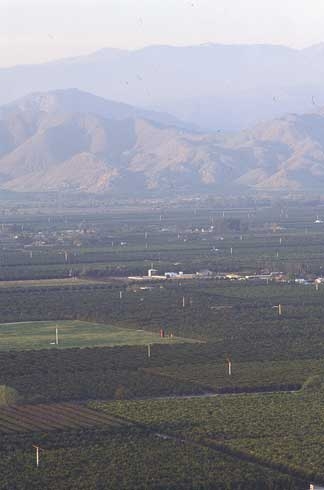(This article summarizes California Department of Pesticide Regulation’s online VOC information.)
It’s that time of year again when hot weather fuels the creation of ground-level ozone, also called smog. High levels of ozone can harm people and crops. Ozone is caused by mixing volatile organic compounds (VOCs), nitrogen oxide, and sunshine. Some pesticides emit VOCs that contribute to ozone formation.
Between May 1 and October 31 when smog is likely to form, using pesticides that release VOCs may be restricted in the five nonattainment areas (NAAs) where ozone levels do not meet federal or state air quality standards:
- Sacramento Metro NAA: all of Sacramento and Yolo counties; parts of El Dorado, Placer, Solano, and Sutter
- San Joaquin Valley NAA: all of Fresno, Kings, Madera, Merced, San Joaquin, Stanislaus, and Tulare counties; parts of Kern
- Southeast Desert NAA: parts of Los Angeles, Riverside, and San Bernardino counties
- South Coast NAA: all of Orange County; parts of Los Angeles, Riverside, and San Bernardino
- Ventura NAA: all of Ventura County
In NAAs, regulations affect field soil fumigation with:
- methyl bromide
- 1,3-dichloropropene
- chloropicrin
- metam sodium
- metam potassium
- dazomet
- sodium tetrathiocarbonate
Regulations may require reduced application rates, specific injection depths, soil compaction requirements, and a tarpaulin repair response plan. Fumigants used in greenhouses and for certain nursery fumigations, potting soil, individual tree and vine replantings, or harvested commodities are not affected.
In the San Joaquin NAA, where 65% of the VOC emissions are from nonfumigant pesticides, regulations begin November 1, 2013 for high-VOC pesticide formulations of:
- abamectin
- chlorpyrifos
- gibberellins
- oxyfluorfen
Pesticides that contain solvents typically release high rates of VOCs. Solid formulations release the least amount. Starting in 2014 a PCA recommendation is required for use during May 1 to October 31. If the VOC emissions level is exceeded, applications for high-VOC formulations may be prohibited.
Whether in a NAA or not, simple steps can minimize the release of VOCs into the air.
- Use other pest management tactics.
- Choose low-emission pesticides or formulations.
- Avoid emulsifiable concentrate (EC) formulations and fumigants.
- Use DPR’s VOC calculators to determine emissions.
- Consider reducing the amount of pesticide applied by spot treating, making fewer applications, or using target-sensing equipment.
- Choose low-emission application methods for fumigants.
- Fumigate and cover with tarpaulins.
- Fumigate and cover with several post-fumigation water treatments.
- Apply through drip irrigation.
- If possible, apply pesticides before May or after October.
- Follow laws and regulations, especially in NAAs where additional regulations may be in effect.
When choosing a pesticide using the UC Pest Management Guidelines, click on the Air Quality button at the top of each treatment table.
- Citrus: http://www.ipm.ucdavis.edu/PMG/selectnewpest.citrus.html
- Avocado: http://www.ipm.ucdavis.edu/PMG/selectnewpest.avocado.html
It will take you to the Department of Pesticide Regulation’s VOC calculators to determine emissions from fumigant and nonfumigant pesticides.
DPR Resources:
- VOC emissions from pesticides: http://cdpr.ca.gov/docs/emon/vocs/vocproj/vocmenu.htm
- Nonattainment area maps: http://cdpr.ca.gov/docs/emon/vocs/vocproj/em_region.htm
- Reducing VOC emissions from field fumigants: http://cdpr.ca.gov/docs/emon/vocs/vocproj/reg_fumigant.htm
- Reducing VOC emissions from nonfumigant pesticide products: http://cdpr.ca.gov/docs/emon/vocs/vocproj/reduce_nonfumigant.htm
- Get on the VOC email list to be alerted about changing situations (go to cdpr.ca.gov and click on “Join E-lists” at the bottom left-hand corner)
Attached Images:
